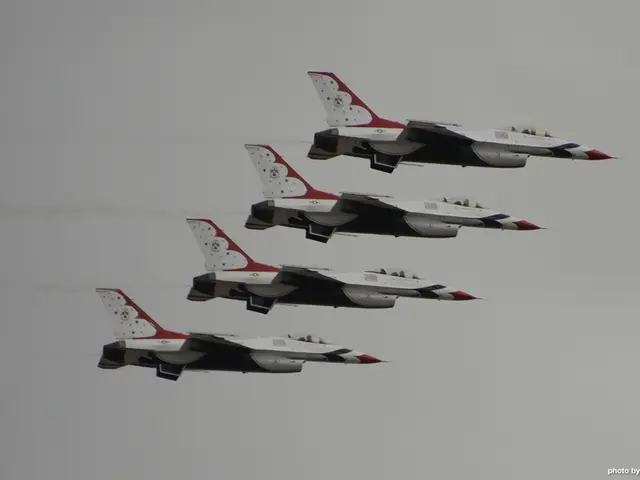Uncommon Instrument Approaches Explained: Insight into the Top 6 Methods
Navigating the skies can be a complex task, and one of the most crucial moments is the approach to landing. Various aviation approach types offer different levels of precision and guidance, each with its unique advantages and limitations. Here's a breakdown of the most common approach types:
Localizer Directional Aid (LDA) Approach
The LDA Approach is a non-precision approach similar to an ILS localizer but not aligned exactly with the runway centerline. It provides lateral guidance using a localizer signal but typically lacks vertical glide path guidance, requiring more pilot manual control and situational awareness.
Precision Approach Radar (PAR)
PAR is a radar-based precision approach where a ground controller provides precise lateral and vertical guidance (azimuth and elevation) to the pilot by radar vectoring. It is usually used in low-visibility conditions and is dependent on ground radar systems and controller instructions.
Approach Surveillance Radar (ASR)
ASR is a radar approach providing lateral guidance only, where the controller gives heading instructions based on radar surveillance but does not provide vertical glide path information. It is less precise than PAR and requires the pilot to control descent.
Localizer-Only Approach (LOC)
The LOC uses the ILS localizer component alone without glide slope guidance. It provides lateral alignment with the runway but no vertical descent guidance, classifying it as a non-precision approach. It is typically used when glide slope equipment is unavailable or unreliable.
Non-Directional Beacon (NDB) Approach
The NDB Approach is a non-precision approach that uses a ground-based radio beacon transmitting in all directions. Pilots use Automatic Direction Finder (ADF) to track the beacon and navigate laterally but must manage altitude without electronic vertical guidance.
Ground Based Augmentation System (GBAS) Approach
GBAS is a precision approach enhancement using ground transmitters to augment GPS signals to provide highly accurate lateral and vertical guidance (similar to ILS). It improves accuracy, integrity, and availability of satellite navigation to enable precision approaches with electronic glide path and localizer-type signals.
| Approach Type | Guidance Provided | Precision | Guidance Source | Remarks | |----------------------|------------------------------|-----------|---------------------------------------|-------------------------------------------------| | LDA | Lateral only | Non-precision | Localizer signal, offset from runway centerline | No vertical glide path; non-ILS aligned | | PAR | Lateral + vertical | Precision | Ground radar and controller | Controller gives verbal instructions | | ASR | Lateral only | Non-precision | Ground radar and controller | Pilot controls vertical descent | | LOC | Lateral only | Non-precision | Localizer from ILS equipment | No glide slope; often fallback if glide slope unavailable | | NDB | Lateral only | Non-precision | Non-directional radio beacon | Old technology; less accurate lateral guidance | | GBAS | Lateral + vertical | Precision | Satellite GPS augmented by ground stations | Precise electronic approach, ILS-like accuracy |
In brief, PAR and GBAS provide precision vertical and lateral guidance, enabling landing in lower visibility, but PAR relies on radar and controllers, while GBAS uses satellite augmentation. Localizer-only, LDA, ASR, and NDB are non-precision approaches providing lateral guidance only, with differing technologies and accuracy levels.
This summary reflects common aviation standards and the information found in the search results. GBAS systems couple ground-based GPS receiver stations with space-based GPS signals. NDB approaches are becoming less common due to decommissioning. Aspen, Colorado (KASE) is an example of an airport that has a LOC-only approach (LOC DME-E). Approach Surveillance Radar (ASR) requires only a functioning radio for navigation, with Air Traffic Controllers vectoring the aircraft to align it with the runway centerline until a visual landing can be made. A Localizer-Only Approach (LOC) is an approach that uses only localizer equipment, as opposed to the typical combination with glideslope equipment in an ILS approach. The Localizer Directional Aid Approach (LDA) is used in areas where the localizer is offset from the runway centerline due to terrain. GBAS approaches are available at a limited number of airports in the USA, including Newark (EWR) and Houston (IAH). States like Alaska still have a significant number of NDBs. Precision Approach Radar (PAR) is similar to an ILS, providing both vertical and lateral navigation guidance to pilots without the use of navigation-reliant cockpit instrumentation. Air Traffic Controllers use radar to guide the aircraft, and these approaches are most commonly found at military bases.
- Pilots navigating via the Precision Approach Radar (PAR) or Ground Based Augmentation System (GBAS) approaches benefit from precision vertical and lateral guidance, enabling landings in lower visibility conditions.
- The PAR approach depends on ground radar systems and controller instructions, while GBAS uses satellite augmentation.
- Localizer-only, LDA, ASR, and NDB are non-precision approaches that provide lateral guidance only, each with distinct technologies and accuracy levels.
- Localizer-Only Approach (LOC) utilizes localizer equipment, unlike the typical ILS combination of localizer and glideslope equipment.
- The Localizer Directional Aid Approach (LDA) is used in areas where the localizer is offset from the runway centerline due to terrain.
- GBAS systems, which use ground-based GPS receiver stations and space-based GPS signals, are available at a limited number of airports in the USA, such as Newark (EWR) and Houston (IAH).
- States like Alaska still have a significant number of Non-Directional Beacon (NDB) approaches, an older technology that provides less accurate lateral guidance.
- Air Traffic Controllers vector aircraft using radar for the Precision Approach Radar (PAR) approach, which is most commonly found at military bases.
- Aspen, Colorado (KASE) is an example of an airport that has a Localizer-Only Approach (LOC-only approach), and Approach Surveillance Radar (ASR) requires only a functioning radio for navigation, with Air Traffic Controllers guiding the aircraft to align it with the runway centerline until a visual landing can be made.








